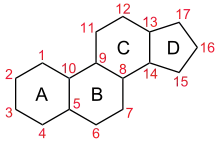
Steranes constitute a class of tetracyclic triterpanes derived from steroids or sterols via diagenetic and catagenetic degradation, such as hydrogenation. They are found in sediments and sedimentary rocks in nature.[1] Steranes are derivatives of gonane, the steroid nucleus which is also called "cyclopentanoperhydrophenanthrene".[2] They have an androstane skeleton with a side chain at the C-17 carbon. The sterane structure constitutes the core of all sterols. Steranes are widely used as biomarkers for the presence of eukaryotes in past ecosystems because steroids are nearly exclusively produced by eukaryotes.[3] In particular, cholestanes are diagenetic products of cholesterol in animals, while stigmastanes are diagenetic products of stigmasterols in algae and land plants.[1] However, some bacteria are now known to produce sterols and it is inferred that the ultimate origin of sterol biosynthesis is in bacteria.[4] Sterols are produced via protosterols that are direct cyclization compounds of squalene by the catalysis of oxidosqualene cyclase.[4] All known sterols in eukaryotes are enzymatically extensively modified from protosterols, while organisms that only produce protosterols are not known. The oldest record of modified steranes are in sedimentary rocks deposited ca. 720–820 million years ago.[5] In contrast, diagenetic products of protosterols (called protostanes and cyclosteranes) are widely distributed in older Proterozoic rocks and imply the presence of extinct proto-eukaryotes and/or sterol-producing bacteria before the evolution of crown-group eukaryotes.[6]
Steranes may be rearranged to diasteranes during diagenesis (C-27 to C-30, rearrangement at C-18 and C-19, no R at C-24). Oils from clastic source rocks tend to be rich in diasteranes.
Cholesterol and its derivatives (such as progesterone, aldosterone, cortisol, and testosterone), are common examples of compounds with the cyclopentanoperhydrophenanthrene nucleus.
See also
References
- 1 2 Peters, K. E.; Walters, C. C.; Moldowan, J. M. (2004). The Biomarker Guide: Volume 1: Biomarkers and Isotopes in the Environment and Human History. Vol. 1 (2 ed.). Cambridge: Cambridge University Press. doi:10.1017/cbo9780511524868. ISBN 978-0-521-78697-3.
- ↑ Yang, Yanqing; Krin, Anna; Cai, Xiaoli; Poopari, Mohammad Reza; Zhang, Yuefei; Cheeseman, James R.; Xu, Yunjie (2023-01-12). "Conformations of Steroid Hormones: Infrared and Vibrational Circular Dichroism Spectroscopy". Molecules (Basel, Switzerland). 28 (2): 771. doi:10.3390/molecules28020771. ISSN 1420-3049. PMC 9864676. PMID 36677830.
- ↑ "About biomarkers". The Summons Lab, Massachusetts Institute of Technology (MIT). November 2006. Archived from the original on 24 April 2020. Retrieved 8 October 2009.
- 1 2 Hoshino, Yosuke; Gaucher, Eric A. (2021-06-22). "Evolution of bacterial steroid biosynthesis and its impact on eukaryogenesis". Proceedings of the National Academy of Sciences. 118 (25). Bibcode:2021PNAS..11801276H. doi:10.1073/pnas.2101276118. ISSN 0027-8424. PMC 8237579. PMID 34131078.
- ↑ Brocks, Jochen J.; Jarrett, Amber J. M.; Sirantoine, Eva; Hallmann, Christian; Hoshino, Yosuke; Liyanage, Tharika (2017-08-31). "The rise of algae in Cryogenian oceans and the emergence of animals". Nature. 548 (7669): 578–581. Bibcode:2017Natur.548..578B. doi:10.1038/nature23457. ISSN 0028-0836. PMID 28813409. S2CID 205258987.
- ↑ Brocks, Jochen J.; Nettersheim, Benjamin J.; Adam, Pierre; Schaeffer, Philippe; Jarrett, Amber J. M.; Güneli, Nur; Liyanage, Tharika; van Maldegem, Lennart M.; Hallmann, Christian; Hope, Janet M. (June 2023). "Lost world of complex life and the late rise of the eukaryotic crown". Nature. 618 (7966): 767–773. Bibcode:2023Natur.618..767B. doi:10.1038/s41586-023-06170-w. ISSN 1476-4687. PMID 37286610. S2CID 259111647.